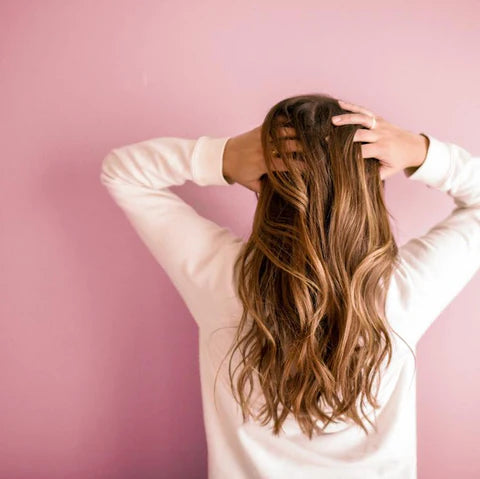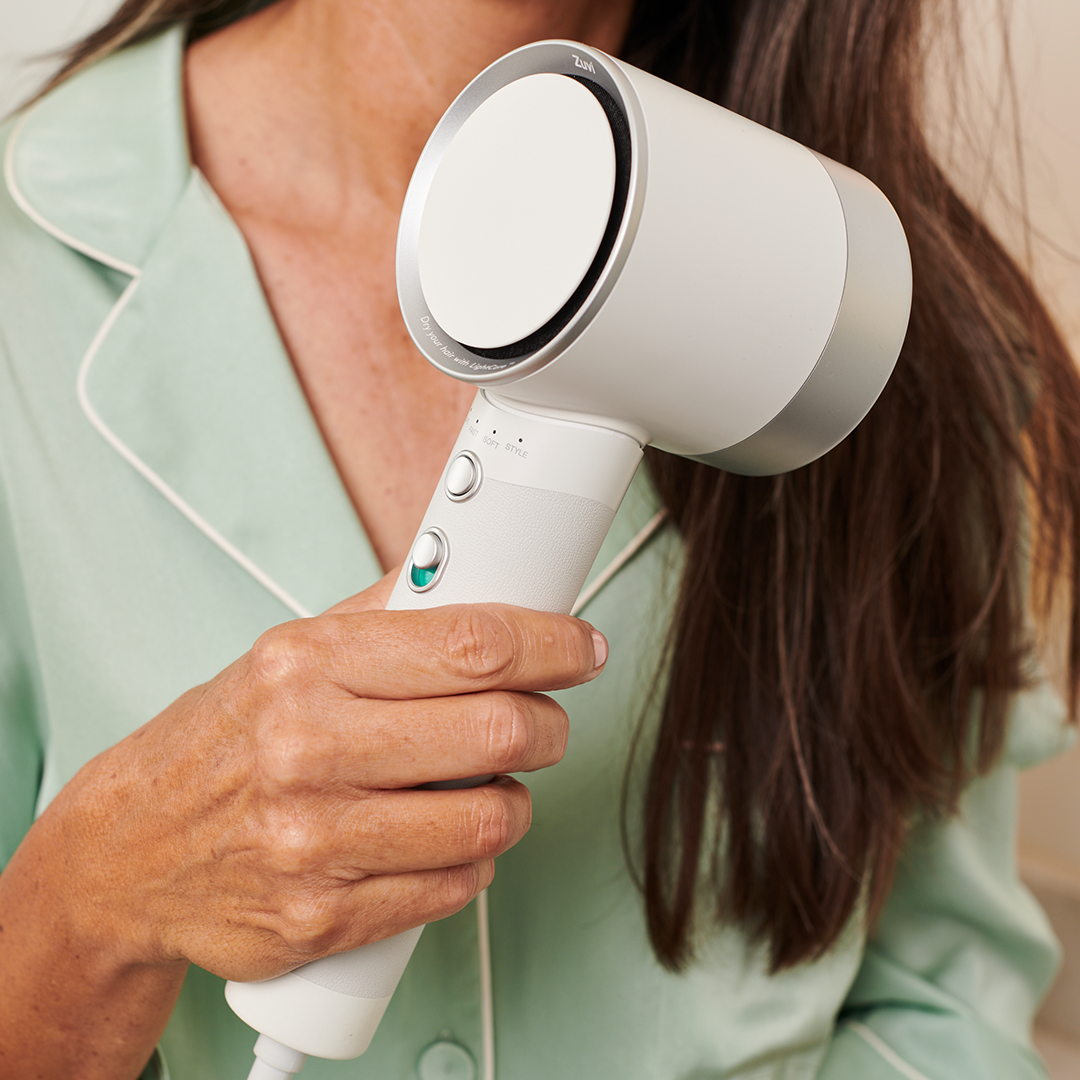What's the healthiest way to dry hair: air drying or blow drying?
The age-old dilemma: is air drying or blow drying the healthiest way to dry hair? In this article, we'll explore the benefits and drawbacks of both drying methods, and introduce you to a brand new third option, that prioritizes hair health and the environment at the same time.
It is only natural to seek the healthiest way to dry hair, since proper hair-drying techniques play a crucial role in maintaining the overall health and appearance of your hair. Whether you prefer letting your hair dry on its own, or using a hair dryer, how you dry your hair can have a significant impact on its condition.
It is well known that hot tools such as hair dryers can cause heat damage to the hair, compromising its structure and health, and because of this, air drying has been considered a better alternative, but is it true? Let's find out what the healthiest way to dry hair is, once and for all!
Air Drying: the Pros and Cons
What is air drying? It's a hair-drying method that involves allowing your hair to dry naturally without the use of heat or mechanical devices like hair dryers. Compared to drying your hair with the help of a hair dryer, it has some benefits:
- Natural and Gentle Method: It is a natural and gentle way of drying your hair. It allows your hair to dry at its own pace without exposing it to excessive heat or manipulation, and it can be a good option for people who can not tolerate the extreme heat of traditional hair dryers
- Reduces Heat Damage: Heat damage is a common concern when using styling tools like hair dryers. Excessive heat can strip the hair of its natural moisture, leading to dryness, brittleness, and breakage. Letting your hair naturally eliminates the risk of heat damage since you are not subjecting your hair to high temperatures.
- Reduces Energy Consumption: As a natural process that does not use any electricity, drying your hair without hot tools helps you reduce your energy consumption and save on electricity bills.
While it has several benefits, it's important to also consider the potential drawbacks associated with this drying technique. Let's explore these drawbacks in detail:
- Longer Drying Time: One of the main drawbacks of air drying is that it generally takes longer for your hair to dry compared to using a hair dryer. This can be a challenge if you're in a hurry or have a busy schedule. It's important to plan ahead and allow enough time for your hair to dry completely, especially if you need to be ready by a specific time.
- Uneven Drying and Styling Challenges: without the control, typical of a hair dryer, drying hair naturally may result in uneven drying, especially if you have thick or long hair. The outer layers of your hair may dry faster while the inner layers remain damp. This can lead to an uneven texture or a lack of uniformity in your hairstyle. Additionally, air drying may make it more challenging to achieve specific hairstyles or desired levels of volume, as the drying process is less controlled compared to using styling tools.
- Suitability for Certain Hair Types: People with very thick or dense hair may find that air drying takes an exceptionally long time, and their hair may remain damp for an extended period, potentially causing discomfort or an increased risk of scalp issues. On the other hand, those with fine or straight hair may find that not using a hair dryer can make their hair appear limp or flat.
Blowdrying: Pros & Cons
Blow drying is a hair drying technique that involves using a blow dryer or hairdryer to speed up the drying process of wet hair. It utilizes a stream of warm or hot air emitted from the blow dryer to evaporate moisture from the hair strands. It is perhaps the most popular way of drying hair because of its speed and convenience:
- Quick and Efficient Drying: One of the significant advantages of blow drying is its ability to provide quick and efficient drying of your hair. Blow dryers generate a controlled stream of warm air, which helps to evaporate moisture from your hair more rapidly compared to air drying. This can be especially beneficial when you're short on time or need to dry your hair before heading out.
- Provides Control and Styling Options: Blow drying offers a level of control that allows you to shape and style your hair as desired. The direct airflow from the blow dryer enables you to manipulate your hair while drying, creating volume, smoothing out frizz, or achieving specific hairstyles. With the use of brushes, round brushes, or diffusers, blow drying allows for increased versatility in styling.
- Adds Volume and Enhances Hair Appearance: Blow drying can give your hair a voluminous boost and enhance its overall appearance. By lifting the roots with the airflow and using brushing techniques, you can create height and fullness, making your hair appear more voluminous and styled. Blow drying can also help to improve the smoothness and shine of your hair, resulting in a polished and well-groomed look.
However, this convenience comes at a price, since hair can suffer damage due to high temperatures and frequent use:
- Excessive Heat can Cause Damage: The primary drawback of blow drying is the potential damage caused by excessive heat. High temperatures can strip the hair of its natural moisture, leading to dryness, brittleness, and increased vulnerability to breakage. Prolonged or frequent use of high heat settings can also damage the hair cuticle, resulting in dullness and rough texture.
- Overuse may lead to Dryness and Breakage: Blow drying too frequently can contribute to dryness and breakage, particularly if proper precautions are not taken. The combination of heat and mechanical stress from the blow dryer and brushes can weaken the hair strands over time, making them more prone to breakage. It's crucial to strike a balance between the convenience and styling benefits of blow drying and allowing your hair to rest and recover between drying sessions.
- Increased Frizz for Some Hair Types: While blow drying can help reduce frizz for many hair types, it can have the opposite effect for individuals with certain hair textures. The heat and strong airflow can potentially exacerbate frizz, especially for those with naturally curly or wavy hair.
Air drying versus blow drying: what does science say?
Turns out, scientists at Yonsei University in Korea have decided to put science to use to finally settle this question: is air drying healthier for hair than blow drying using a hot tool? The result of their testing may surprise you.
The study examined the effects of repeated shampooing and hair drying at various temperatures on the ultra-structure, morphology, moisture content, and color of hair. It was found that heat damage primarily affected the hair surface and cuticle layers.
In this study, different drying methods were evaluated, including natural drying and using a hair dryer at different temperatures. The results showed that hair dried without a hair dryer had relatively well-protected surfaces, while hair dried with a hair dryer exhibited more surface damage. Increasing the temperature during hair drying resulted in more severe surface damage, with the highest temperature causing the most significant damage. However, no damage to the hair cortex was observed in any group, suggesting that the hair surface acts as a barrier against cortex damage. The cell membrane complex (CMC) was only damaged in the naturally dried group, which was unexpected. The moisture content decreased in all treated groups, but the differences were not statistically significant. Changes in hair color, particularly lightening, occurred after repeated shampooing and drying, with ambient temperatures and 95℃ temperatures causing earlier color changes. The exact reason for the color change is unknown but may be related to the damage to the hair cuticle. Although natural drying is often considered safer, this study suggests that using a hair dryer at a distance of 15 cm with continuous motion causes less damage than air drying.
So science settled it: air drying is not the healthiest hair drying method, but blowdrying still poses some danger to hair health due to the higher temperatures that are shown to cause damage to the outer layer of the hair.
The Healthiest Way to Dry Your Hair: Zuvi Halo
Both air drying and blow drying have their benefits, and as shown by science, ideally, we'd dry our hair using a combination of both. Thankfully, we do have the solution: Zuvi Halo is a high-tech hair dryer that combines the best of air drying, with the precision and control of blowdrying.
Zuvi Halo leverages a patented technology called LightCare ™, which uses a combination of wind and beneficial infrared light, that mimics the natural effect of the combination of sun and wind to quickly evaporate raindrops. This process harnesses the best of air drying but at a faster rate that does not cause bulging in the cell membrane complex of your hair, and without the harmful effects of heat damage caused by the high temperatures of traditional hair dryers.
Zuvi Halo Pros:
- The healthiest way to dry hair thanks to nature-inspired LightCare ™ technology that avoids heat damage to the outer and inner layers of the hair
- Energy-efficient, uses up to 60% less energy compared to traditional hair dryers
- Fast drying time compared to air drying, and as fast of that of other premium hair dyers on the market
Zuvi Halo Cons:
- New technology, some people might need some time to adjust to this new drying method and find their optimal hair drying routine
- More costly than air drying
Best Practices for Healthy Hair Drying
Grab your towel and Zuvi Halo, because we're about to dive into the art of hair drying. We'll share some tips and to ensure your hair remains healthy, shiny, and damage-free. From towel blotting to regular maintenance of styling tools, we've got you covered.
Towel Blotting to Remove Excess Moisture
After washing your hair, resist the temptation to vigorously rub your hair with a towel. Instead, opt for gentle towel blotting. Take a soft, microfiber towel and gently press it against your hair to absorb excess moisture. Avoid twisting or rough movements that can cause friction and lead to hair breakage. Remember, when hair is wet, is the most fragile.
Blotting your hair reduces the time it takes for your hair to air dry or minimizes the heat exposure needed during blow drying.
Maintaining a Safe Distance between the Hair Dryer and Hair
When blow drying your hair, it's crucial to maintain a safe distance between the hair dryer and your precious locks. Hold the hair dryer at least 15 cm (6 inches) away from your hair to control heat exposure. This distance allows the airflow to disperse and evenly dry your hair without causing damage.
Select the lowest temperature setting
When given the option, use the cooler or medium heat setting on your hair dryer to minimize heat-related harm. Zuvi Halo has three smart drying modes for you to try, and we recommend starting with Care or Soft mode, which use gentler temperatures optimized for hair and scalp health.
Regular Maintenance and Cleaning of Hair Styling Tools
Hair styling tools, including hair dryers, brushes, and combs, accumulate product and oil buildup, dust, and debris over time. Make it a habit to clean your styling tools regularly to ensure optimal performance and prevent transferring dirt and residue back onto your hair.
Wipe down the outer surface of your hair dryer with a damp cloth to remove any grime. Clean your brushes and combs by removing trapped hair strands and washing them with a mild shampoo or warm soapy water. Rinse thoroughly and allow them to dry completely before using them again.
Conclusion
In this article, we have explored the pro and cons of two of the most popular hair drying techniques: air drying and blow drying. Despite popular belief, leaving your hair to dry naturally without using a hair dryer is not necessarily better, as shown by a scientific study that debunked this myth. However, drying your hair with a traditional hair dryer can cause damage to the hair due to the high temperatures, that bake your hair inside out. We introduced a third, healthier option, drying your hair with the new Zuvi Halo, which combines the benefits of both hair drying methods, leaving your hair shiny, smooth and beautiful.




Leave a comment
All comments are moderated before being published.
This site is protected by hCaptcha and the hCaptcha Privacy Policy and Terms of Service apply.